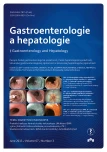Faecal incontinence
Authors:
Š. Malá; M. Pipková; J. Šťovíček; R. Keil; M. Kvapil
Authors‘ workplace:
Interní klinika 2. LF UK a FN v Motole, Praha
Published in:
Gastroent Hepatol 2013; 67(3): 207-211
Category:
Clinical and Experimental Gastroenterology: Review Article
Overview
Faecal incontinence is a serious condition that significantly reduces the quality of life. Up to 15% of the population suffer from this disease. A detailed history and physical examination are essential parts of the diagnostic process. Currently, there are a number of methods such as anorectal manometry and anal endosonography that help reveal the causal mechanism of the faecal incontinence. The therapy is aimed at treating the primary cause. Pelvic floor physiotherapy is safe and effective method of treatment. Patients who suffer from diarrhea with a ruled out organic cause can benefit from antidiarrheal medication. For elderly patients with a history of faecal impaction, proper hygiene, exercise and regular complete bowel emptying are important.
Key words:
faecal incontinence – anorectal manometry – anal endosonography – pelvic floor physiotherapy – antidiarrheal medication
Sources
1. Rao, SS. Diagnosis and management of fecal incontinence. Am J Gastroenterol 2004, 99(8): 1585–1604. Dostupné z: http://s3.gi.org/physicians/guidelines/FecalIncontinence.pdf.
2. Fecal incontinence in adults. UpToDate [online], 2012 [cit. 2012-04-25]. Dostupné z: http://www.uptodate.com/contents/fecal-incontinence-in-adults.
3. Fecal incontinence in elderly patients: common, treatable, yet often undiagnosed. Cleve Clin J Med 2003; 70(5): 441–448.
4. Inkontinence stolice ve stáří. Medicína pro praxi. 2005, 4. Dostupné z: http://www.medicinapropraxi.cz/pdfs//med/2005/04/02.pdf.
5. Kamm MA. Obstetric damage and faecal incontinence. Lancet 1994; 344(8924): 730–733.
6. Aitchison M, Fisher BM, Carter K et al. Impaired anal sensation and early diabetic faecal incontinence. Diabet Med 1991; 8(10): 960–963.
7. Anorektální dysfunkce – úvod a diagnostika. Poznatky pro klinickou praxi. Čes a Slov Gastroent a Hepatol 2006; 60(2): 65–69.
8. Rao SS. Update on testing and treatment of fecal incontinence. World Gastroenterol N 2005; 10(1): 22–25. Dostupné z: http://www.worldgastroenterology.org/assets/downloads/pdf/pub/wgn/wgn2005_1.pdf.
9. Minimum standards of anorectal manometry. Neurogastroenterol Mot 2002; 14: 553–559. Dostupné z: http://www.synecticsmedical.com/pdf/AnolrectalManometryMinimumStandards.pdf.
10. American Gastroenterological Association medical position statement on anorectal testing techniques. Gastroenterology 1999; 116(3): 732–760.
11. Rao SS, Patel RS. How useful are manometric tests of anorectal function in the management of defecation disorders? Am J Gastroenterol 1997; 92(3): 469–475.
Labels
Paediatric gastroenterology Gastroenterology and hepatology SurgeryArticle was published in
Gastroenterology and Hepatology

2013 Issue 3
Most read in this issue
- Faecal incontinence
- Asacol 800™ mg tablets
- Current position and future trends of therapy in ulcerative colitis
- Health risks of endoscopy for endoscopists in the Czech Republic – a pilot study
